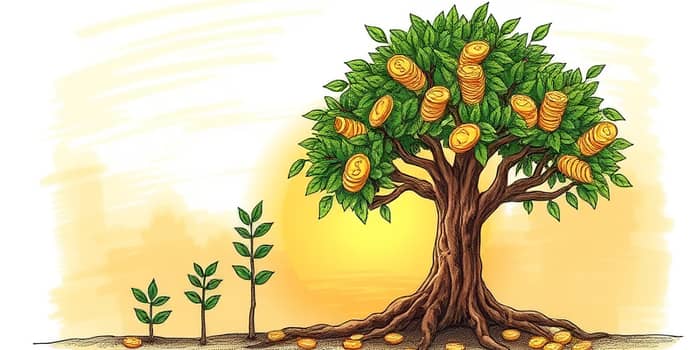
Compounding growth is one of the most potent forces in finance and wealth creation. By reinvesting earnings rather than withdrawing them, you unlock exponential potential that simple interest cannot match.
Whether you’re saving for retirement, building an emergency fund, or growing a business, the principles of compounding apply universally and can transform modest contributions into substantial wealth.
At its core, interest on interest, which accelerates growth, differentiates compound interest from its simple counterpart. Each period’s earnings are added to the principal, so your investment base expands continuously.
Albert Einstein famously called compound interest the “eighth wonder of the world” because of its ability to turn small sums into significant fortunes over long horizons.
The formula for compound interest reveals how variables interact. The compound interest formula shows variable impacts on your final amount, guiding decisions on rate, time, and compounding frequency.
You can calculate potential returns using A = P (1 + r/n)n t, where A is the final amount, P is principal, r is annual rate, n is compounding periods per year, and t is time in years.
To illustrate the difference, consider $1,000 invested at 10% annually for three years:
Though modest over three years, the divergence widens dramatically over decades, demonstrating why early and sustained reinvestment matters.
Over time, compound interest outpaces simple interest by an ever-increasing margin, thanks to its compounding nature.
Imagine depositing $10,000 into an account earning 5% annual interest, compounded once per year. Each year’s growth becomes part of the principal for the next calculation.
Over ten years, this modest rate yields a powerful accumulation of wealth purely through systematic reinvestment.
Several variables determine how quickly your investments compound:
Understanding and optimizing each factor helps you tailor a strategy that maximizes growth potential.
Dividends and interest distributions offer powerful levers to supercharge growth. By opting into automatic reinvestment, you turn payouts into additional shares or units, boosting your base.
Investors who choose reinvestment often experience steady portfolio expansion over time, compared to those who receive payouts as cash and underutilize their full earning potential.
Mutual funds and ETFs commonly provide dividend reinvestment programs, allowing seamless integration of earnings without manual intervention.
Compounding demands discipline and a long-term perspective. Market volatility can tempt investors to sell low and miss out on recoveries.
Seasoned investors adopt a mindset where delayed gratification is rewarded over time. They view downturns as opportunities to buy at lower prices and refuse to withdraw earnings impulsively.
Developing emotional resilience and a clear plan helps you stay invested through market swings, ensuring compounding remains uninterrupted.
While often discussed in banking and investing, compounding principles extend to diverse areas:
Recognizing both sides of compounding empowers you to leverage benefits and mitigate risks.
Modern platforms and tools simplify compounding strategies:
Even with compounding on your side, mistakes can erode growth:
Withdrawing earnings interrupts the compounding cycle.
High fees, excessive trading, or chasing risky trends can reduce net returns. Moreover, ignoring inflation risks leaving your real purchasing power stagnant.
Prioritize low-cost, diversified investments and maintain a focus on long-term growth rather than short-term gains.
Consistent reinvestment and compounding returns over decades depend on disciplined execution and avoiding emotional decisions.
Warren Buffett, one of history’s greatest investors, began buying stocks as a child. By reinvesting dividends and profits back into his enterprises, he harnessed the math of compounding across multiple market cycles.
Buffett’s unwavering commitment to value investing and disciplined reinvestment transformed modest initial stakes into a multibillion-dollar empire.
Time is the most critical ingredient in the compounding recipe. Starting early grants your money more periods to grow, making even small contributions meaningful.
Take concrete steps today: set up automatic reinvestments, calculate potential outcomes with an online tool, and commit to a regular contribution schedule. Each additional day compounds your wealth further.
Remember, true financial independence is built gradually. By embracing reinvestment and the power of compounding, you position yourself for enduring success and prosperity.
References













